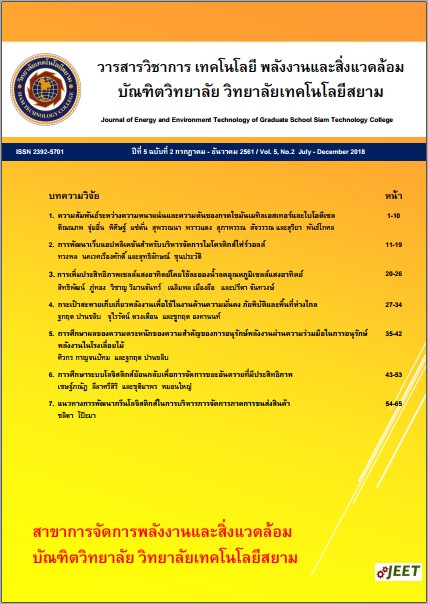Energy Harvesting Backpack for Applications in Security, Disaster and Remote Areas
Main Article Content
Abstract
This research aims to develop a prototype of energy harvesting backpack for applications in security, disaster and remote areas. In the backpack, it will compose of five devices as electrical energy storage, global positioning system (GPS), energy harvesting systems, energy management processing unit, and bulletproof system (for security). The energy harvesting system composes of solar panel 10W power as the main power source, and piezoelectric generator 200mW capacity as optional power generating device in case of no light source or in the forest which produce electricity from the user’s movement instead. The backpack was designed base on ergonomics and back support to reduce fatigues. Besides, the energy harvest devices were able to reduce the battery’s weight without effect on operation periods. In addition, as a soldier usually walks for a long distance during patrol, the use of piezoelectric generator is effectively suitable. However, the energy harvesting from motion is not steady so, the high charging rate energy storage such as capacitor has been used for energy stabilizing. On the experiment, energy harvest backpack can power the radio with 2W transmission power up to 26 hours and standby up to 52 hours.
Article Details
เนื้อหาและข่อมูลในบทความที่ลงตีพิมพ์ในวารสารวิชาการ เทคโนโลยี พลังงาน และสิ่งแวดล้อม บัณฑิตวิทยาลัย วิทยาลัยเทคโนโลยีสยาม ถือเป็นข้อคิดเห็นและความรับผิดชอบของผู้เขียนบทความโดยตรง ซึ่งกองบรรณาธิการวารสารไม่จำเป็นต้องเห็นด้วย หรือว่าร่วมรับผิดชอบใด ๆ
บทความ ข้อมูล เนื้อหา รูปภาพ ฯลฯ ที่ได้รับการตีพิมพ์ในวารสารวิชาการ เทคโนโลยี พลังงาน และสิ่งแวดล้อม บัณฑิตวิทยาลัย วิทยาลัยเทคโนโลยีสยาม ถือเป็นลิขสิทธิ์ของวารสารวิชาการ เทคโนโลยี พลังงาน และสิ่งแวดล้อม บัณฑิตวิทยาลัย วิทยาลัยเทคโนโลยีสยาม หากบุคคล หรือหน่วยงานใดต้องการนำทั้งหมด หรือส่วนหนึ่งส่วนใดไปเผยแพร่ต่อ หรือเพื่อกระทำการใด ๆ จะต้องได้รับอนุญาต เป็นลายลักษณ์อักษรจากวารสารวิชาการ เทคโนโลยี พลังงาน และสิ่งแวดล้อม บัณฑิตวิทยาลัย วิทยาลัยเทคโนโลยีสยาม เท่านั้น
References
[2] Rome, Lawrence (Strafford, PA, US), 2008, Backpack for harvesting electrical energy during walking and for minimizing shoulder strain, United States, Lightning Packs LLC (Strafford, PA, US) 7391123.
[3] Cavagna, G.A. and Franzetti, P., 1986. The determinants of the step frequency in walking in humans. The Journal of physiology, 373(1), pp.235-242.
[4] Cavagna, G., Mantovani, M., Willems, P. et al., 1997, The resonant step frequency in human running, Pflügers Arch, Volume 434, Issue 6, pp 678–684.
[5] G De Pasquale, A Somà, F Fraccarollo., 2013, Comparison Between Piezoelectric and Magnetic Strategies For Wearable Energy Harvesting, Journal of Physics: Conference Series, Vol. 476., 012097.


